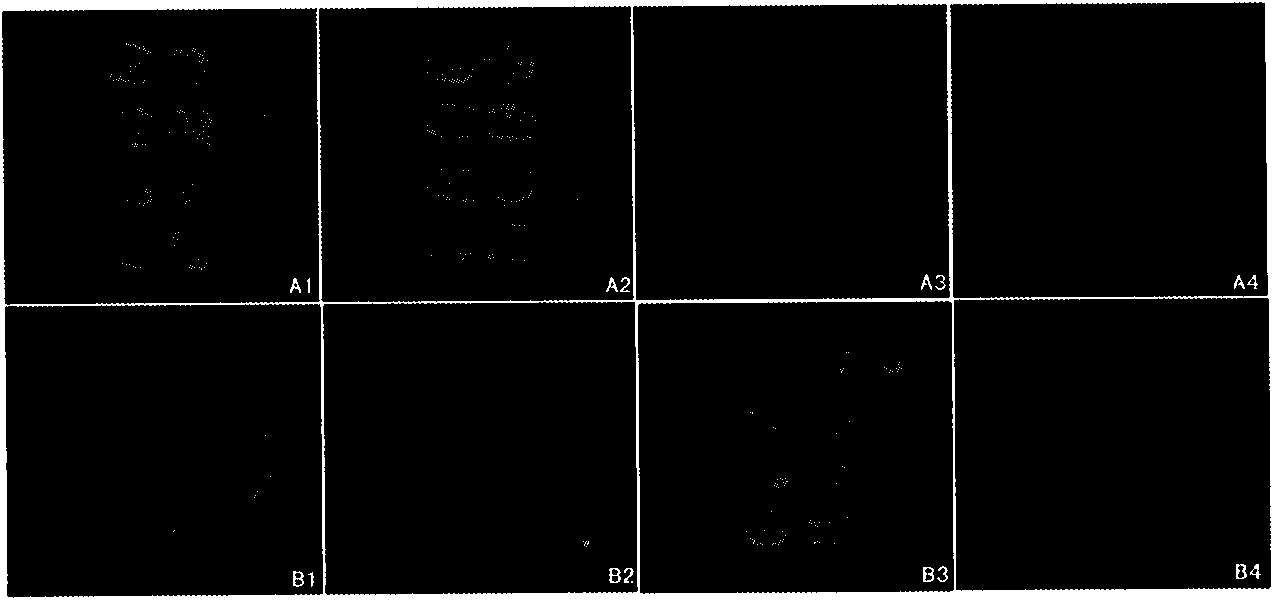Immunity detection chip of prawn white spot syndrome virus (WSSV) and preparation method thereof and application
An immunodetection and vitiligo technology is applied in the field of immunodetection chip or microarray, preparation, and improvement of marine aquaculture animal pathogen detection technology, which can solve the problems of prone to false positives, poor sensitivity, poor practicability, etc. Fast, simple effects
- Summary
- Abstract
- Description
- Claims
- Application Information
AI Technical Summary
Problems solved by technology
Method used
Image
Examples
Embodiment 1
[0053] 1. Antibody acquisition and purification
[0054] WSSV was extracted from the target organ of white spot virus diseased prawns, and purebred New Zealand white rabbits were immunized by conventional methods, blood was collected to prepare serum, and rabbit anti-WSSV antibodies were obtained.
[0055] Mouse hybridoma cell lines monoclonal antibody D and monoclonal antibody E were recovered and cultured, and mice were injected into the peritoneal cavity to produce ascites, and a large amount of high-titer, high-specificity mouse anti-WSSV monoclonal antibody was obtained.
[0056] Take monoclonal antibody D and monoclonal antibody E purified by affinity chromatography, mix them, and routinely immunize purebred New Zealand white rabbits, collect blood to prepare serum, and obtain rabbit anti-mouse Ig antibody.
[0057] The resulting antibody was purified using an affinity chromatography column (HiTrap Protein G SepharoseColumn) from Amersham Phamacia Biotech.
[0058] 2. P...
Embodiment 2
[0071] Steps 1, 2, 3, and 4 are the same as in Example 1.
[0072] 5. Preparation of Agarose Gel Substrates
[0073] Prepare a 1.2% agarose solution, boil it in a microwave oven for 3 minutes to dissolve it completely, spread 2mL of the agarose solution on a clean slide treated with affinity silane preheated at 60°C; after the agarose solidifies, dry the slide overnight at 37°C ; Use 0.02mol / L NaIO before use 4 The solution was activated at room temperature for 30 minutes, rinsed thoroughly with ultrapure water three times, blown dry with nitrogen flow, and stored in a dry place at room temperature.
[0074] 6. Antibody Immobilization
[0075] ①Dilute rabbit anti-WSSV antibody and rabbit anti-mouse Ig antibody with PBS buffer solution containing 10%, 20%, 30%, 40%, 50%, and 60% glycerol at pH 7.4 to make the concentration 0.1mg / mL .
[0076] ② Spot the antibody dilution on different areas of the surface of the glass slide with a spotting instrument. Each chip has two rows ...
Embodiment 3
[0079] Steps 1, 2, 3, 4, 5 are the same as in Example 2.
[0080] 6. Antibody Immobilization
[0081] ①Dilute the rabbit anti-WSSV antibody with PBS buffer solution containing 50% glycerol at pH 7.4 to make the concentration 0.5, 0.1, 0.05, 0.01, 0.005, 0.001, 0.0005, 0.0001 mg / mL.
[0082]②Use a spotting instrument to spot different concentrations of antibody dilutions on different areas of the slide surface. Each chip has two rows and four columns with a total of eight 4×4 subarrays, and each subarray contains different concentrations of rabbit anti-WSSV antibodies. Each subarray is separated by a chip-specific fence or a Super PAP Pen to form an independent reaction unit. Place in saturated humidity at 37°C for 2 hours, wash and dry.
[0083] ③ Add 3% bovine serum albumin dropwise to the area on the slide where the antibody is spotted to block, place at 37°C in saturated humidity for 1 hour, wash, dry, and seal and store at 4°C to obtain the prawn white spot virus immunoa...
PUM
 Login to View More
Login to View More Abstract
Description
Claims
Application Information
 Login to View More
Login to View More - R&D
- Intellectual Property
- Life Sciences
- Materials
- Tech Scout
- Unparalleled Data Quality
- Higher Quality Content
- 60% Fewer Hallucinations
Browse by: Latest US Patents, China's latest patents, Technical Efficacy Thesaurus, Application Domain, Technology Topic, Popular Technical Reports.
© 2025 PatSnap. All rights reserved.Legal|Privacy policy|Modern Slavery Act Transparency Statement|Sitemap|About US| Contact US: help@patsnap.com



